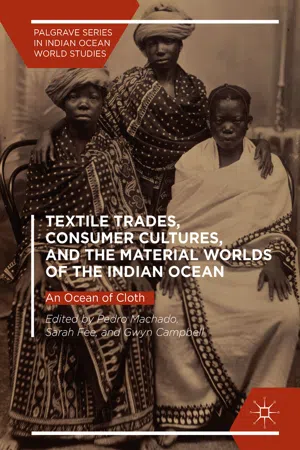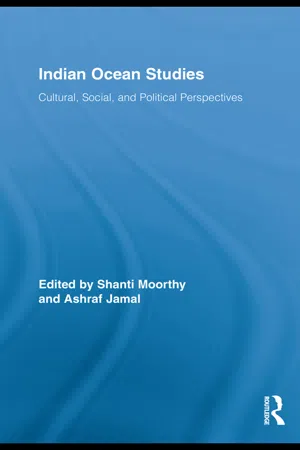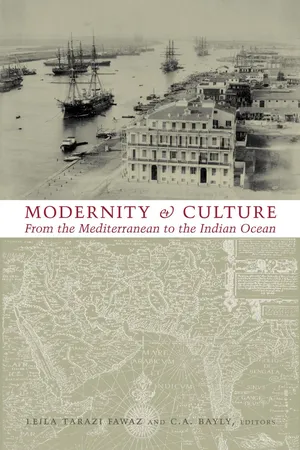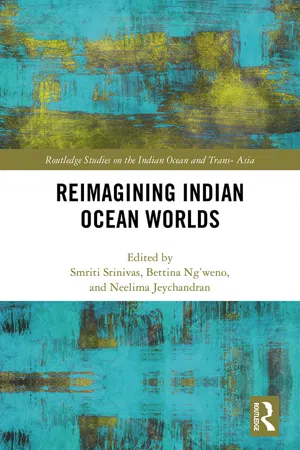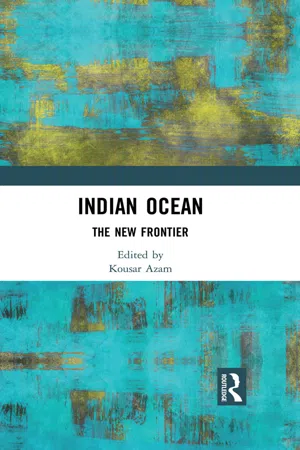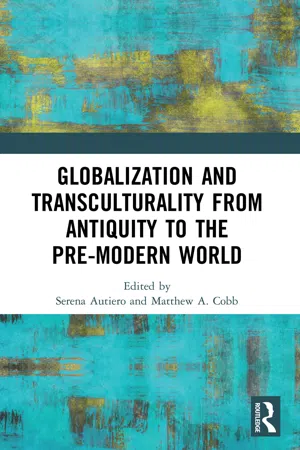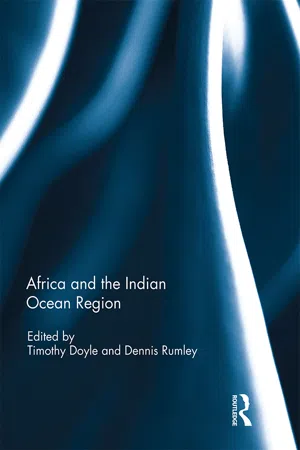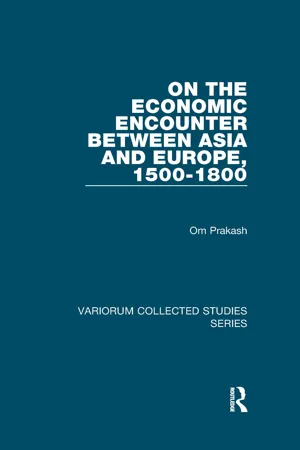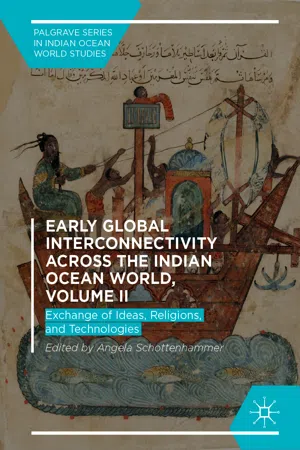History
Indian Ocean Trade Cultural Impact
The Indian Ocean Trade had a significant cultural impact on the regions it connected. It facilitated the exchange of ideas, religions, languages, and technologies between Africa, Asia, and Europe. This cultural exchange contributed to the development of new cultural practices and the spread of existing ones.
Written by Perlego with AI-assistance
Related key terms
9 Key excerpts on "Indian Ocean Trade Cultural Impact"
- eBook - ePub
- Pedro Machado, Sarah Fee, Gwyn Campbell, Pedro Machado, Sarah Fee, Gwyn Campbell(Authors)
- 2018(Publication Date)
- Palgrave Macmillan(Publisher)
Cloth is remarkably dynamic. It is woven, exchanged and creatively adapted in myriad ways. It also affects relationships intimate and distant by translating aesthetics, desires and social ideals into the language of exchange. As a result, textiles are key to understanding the history of global exchange and social relation. The essays in this volume suggest that we cannot fully understand the socio-economic fabric of the Indian Ocean without reflecting on textiles, and we cannot write the global history of fashion and textile production without concerted reflection on the Indian Ocean region. More precisely, the production, exchange and consumption of textiles offer unique windows on Indian Ocean connectivity and the region’s articulation with the wider world. The research presented in this important collection elaborates these points by tracing the long life cycles of cloth destined for Indian Ocean markets. Indeed, the essays address several questions critical to understanding Indian Ocean linkages and patterns of global interface: What are the social meanings of cloth in Indian Ocean contexts? How is cloth transformed in its circulation? How have textiles articulated Indian Ocean economies with the global economy?Interdisciplinary research on the Indian Ocean has greatly enhanced our understanding of its matrix of linked socio-economic systems, a space of “related but different social worlds”, in Kai Kresse and Edward Simpson’s words.1 These social worlds were constituted by centripetal forces, including the monsoon pattern, exchange, migration, religion and empires. Those forces, in turn, fostered notions of affinity and equivalence. Many objects of material culture evidence Indian Ocean socio-economic linkages. The dhow, for example, has for centuries been a primary symbol of transoceanic connectivity.2 Yet, few objects of Indian Ocean material culture are as transcendent as cloth. Many of the sartorial choices of people along the Indian Ocean rim, past and present, reflect regional aesthetic communities. From the latest Dubaiabayato variations on the Indonesian men’s tubularsarong— alternatively known as lungi (Bangladesh and India), izaar (Oman), macawis (Somalia) and shuka - eBook - ePub
Indian Ocean Studies
Cultural, Social, and Political Perspectives
- Shanti Moorthy, Ashraf Jamal, Shanti Moorthy, Ashraf Jamal(Authors)
- 2010(Publication Date)
- Routledge(Publisher)
Port Cities and Intruders , it was precisely cloth, namely from Coromandel and Gujarat, which was often bartered and exchanged in the meetings between littoral peoples and those who crossed the ocean. These fabrics varied from lay cotton to the finest of silks, and with the trading thereof arose the means to reproduce their designs.What I’m getting at is that exchanges were not solely economic and utilitarian; they were also imaginary and creative. My supposition, therefore, is not the prevailing one, that the currency of trade was the fulcrum of the Indian Ocean world; a view which, now in the process of being reevaluated, has allowed Sugata Bose in A Hundred Horizons to note that “the overemphasis on trade has tended to obscure much else that went along with it, especially the flow of ideas and culture.”6 With this qualification Bose then adds: “The exploration of the Indian Ocean as a cultural milieu is quite as important as its role as a trading zone.”7 My own qualification is by no means as cautious. Rather, mine is a view which stresses that it is precisely trade which is informed by the flow of ideas and culture. Stephen Muecke and Devleena Ghosh, in Cultures of Trade: Indian Ocean Exchanges , concur, for “as much as the East was plundered for profit, the return cargo was a strangely powerful complex of cultural forces, as heady as the perfumes, as fabulous as the imagined and real treasures, as reproductive as the libidinal fantasies of the exotic.”8 - eBook - ePub
Modernity and Culture
From the Mediterranean to the Indian Ocean
- Robert Ilbert, Leila Fawaz, C. A. Bayly(Authors)
- 2002(Publication Date)
- Columbia University Press(Publisher)
Temporal ThresholdsI would add that there were strands other than the ties of intermediary capital that sustained the Indian Ocean rim as an inter-regional arena of economy and culture. My own research on the period from about 1800 to 1950 suggests that pre-existing inter-regional networks were utilized, molded, reordered, and rendered subservient by Western capital and the more powerful colonial states, but never torn apart until these came under severe strain during the 1930s. Almost throughout the age of European colonialism, the Indian Ocean rim was characterized by specialized flows of capital and labor, skills and services, ideas and culture. Not to be mistaken as continuity between the pre-colonial and colonial eras, this calls for a reinterpretation of the nature of the European colonial and para-colonial enterprise of domination, as well as a subtler understanding of the unities and distinctive features of the cultures and idioms of anti-colonial resistance. As I study the fortunes and fears of migrant Indian merchants, moneylenders, soldiers, and laborers, I am more convinced than ever of the imperative of blending imaginatively the dimensions of economy, politics, and culture in a reconceptualization of the Indian Ocean as an inter-regional arena in the nineteenth and twentieth centuries. But if theory is not to be disconnected from history and space from time, I need at this stage to turn to that part of the canvas where temporal thresholds can be sketched in and juxtaposed with the sweeping lines of spatial limits.The Indian Ocean has been traversed by a number of distinguished historians of the longue durée. Whether they have taken on a whole millennium or just a couple of centuries, most have chosen to concentrate on the premodern and early modern periods. What emerges from these studies of long- and medium-term movements in trade and culture in the Indian Ocean until the eighteenth century is a picture of a well-integrated inter-regional arena of economic and cultural interaction and exchange. Particularly important connections of material life, politico-military organization, economic institutions, and social-religious ideology were forged across the Ocean during the millennium that stretched from the eighth to the eighteenth century. The modification of these links in the late eighteenth and early nineteenth century has been shown by C. A. Bayly to have critically influenced the nature of the colonial transition in South and Southeast Asia and European ascendancy in the Middle East.25 - eBook - ePub
- Smriti Srinivas, Bettina Ng'weno, Neelima Jeychandran, Smriti Srinivas, Bettina Ng'Weno, Neelima Jeychandran(Authors)
- 2020(Publication Date)
- Routledge(Publisher)
While Portuguese aggression affected the politics of the Indian Ocean region, the emergent Atlantic economy became enmeshed in Indian Ocean exchanges in ways that also effectively expanded the socioeconomic worlds of the Indian Ocean. American silver and gold, for instance, more deeply integrated Indian Ocean societies with wider economic spheres and fluctuations in value (Parthasarathi 2011; Vink 2007). From the Pacific to the Mediterranean and Atlantic, Indian Ocean products reoriented global commerce. For instance, the transatlantic slave trade depended to a great degree on European and Western African merchants’ access to South Asian cotton cloth (Kobayashi 2019; Parthasarathi 2011). Greater global interdependence also shaped South Asian production. For instance, in the mid-1660s more than 45 percent of Bengal’s export trade was with Europe, while Japan absorbed an additional 40.72 percent (Prakash 1985: 75). The production and aesthetics of South Asian textiles were increasingly shaped by international consumer interests, and they likewise affected tastes across the globe (Parthasarathi 2018; Riello and Roy 2009).As the societies of the Indian Ocean and Atlantic basins were becoming more interdependent, the Indian Ocean also saw new regional geographies of relation, particularly in the contexts of the slave trade and indenture (Anderson 2012). The Mascarenes, for example, became creole plantation societies that bore structural similarities to Caribbean colonies, yet the population was almost entirely made up of people forcibly brought to the islands from Eastern Africa and Madagascar. Perhaps no location represents the expansion of boundaries of relation better than Cape Town, which from the seventeenth century became the new threshold of the Indian Ocean world. More than a gateway, Cape Town became a fulcrum of changing relationalities, a space of a great many “horizons.” The growth of Cape Town represented a significant extension of the Indian Ocean world into new lands. Not only was Cape Town directly linked to Batavia, but the Dutch East India Company also delivered enslaved Southeast and South Asians to the city from Java, Sulawesi, Bengal, Coromandel, Malabar, and Sri Lanka. Likewise, people from Madagascar and Mozambique were brought to the Cape in bondage and later indenture (Harries 2014; Ross 1983; Ward 2007, 2009; Worden 2016). These groups and their descendants defined the culture and society of the Cape. Islam as well as languages such as Arabic, Buginese, and Tamil were embedded in the Western Cape’s cultural landscape and shaped the emergent Afrikaans language, testimony to the remarkable expansion of Indian Ocean social worlds in the early modern era (Jeppie 2011). - eBook - ePub
Indian Ocean
The New Frontier
- Kousar J Azam(Author)
- 2019(Publication Date)
- Routledge(Publisher)
Their continued and expanding naval presence turned into a rivalry aimed for political and economic advantage and quest for markets for the vast quantities of military and consumer goods. Their increased presence converted it into an area of turbulence and tension, a focal point for crises of all description and an area of crucial geostrategic importance. Indian Ocean became a hot bed of oceanic designs of superpowers and their competing strategic and commercial interests led to rapid arms buildup both conventional and nuclear. Concerned with this growing rivalry, the States of the Indian Ocean region came together to oppose the superpower naval build up. In 1971, on a Sri Lankan proposal, the UN General Assembly declared the Indian Ocean as a Zone of Peace and took practical measures by establishing the Ad Hoc Committee on the Indian Ocean to consult the Great Powers to persuade them to abstain from further military expansion in the Indian Ocean. 9 With the military buildup and local response Indian Ocean gradually became an important area of study and investigation. Indian Ocean studies attracted scholars not merely because of its long history, they also applied interdisciplinary and comparative approaches to social, economic, political, and cultural interactions within and its linkages beyond the Indian Ocean in the past and present. These studies have made significant contributions to the understanding of the nature and dynamics of regional and pan-regional issues. Scholars from anthropology, archeology, economics, geography, history, marine sciences, political science, and sociology have made innovative studies on topics such as human migration, cultural and religious diversity, trade and commerce, imperialism and colonialism, globalization and about the abundant resources on the Indian Ocean bed and their exploration - Serena Autiero, Matthew Adam Cobb, Serena Autiero, Matthew Adam Cobb(Authors)
- 2021(Publication Date)
- Routledge(Publisher)
Trade, Commerce and the State in the Roman World . Oxford: Oxford University Press.Passage contains an image
Matthew A. Cobb8 Mediterranean goods in an Indian context
The use of transcultural theory for the study of the ancient Indian Ocean world *
DOI: 10.4324/9781003096269-12Introduction
The recent growth of interest in trade and interconnectivity across the ancient Afro-Eurasian world (c . 300 BCE – 700 CE) has been spurred on by a number of factors. One of these is evidential: new archaeological discoveries have been made at a range of sites across the globe, while more epigraphic, papyrological and numismatic studies have also been undertaken.1 A second major factor is the development of scholarly interest in global history and the history of globalization, which are both concerned with how things, people and ideas circulated, as well as how individuals and groups within different societies responded to these movements and exchanges (including socio-economic, political and cultural responses).2These developments have spurred engagement with a whole range of issues, including the traditional concerns of long-distance trade, such as networks, nodes, organization, financing, sailing technology, the goods exchanged, and the merchants and sailors involved. There has also been an expanded interest into how this trade was integrated into wider socio-economic activity, such as the production, cultivation and reworking of items of exchange, and habits of consumption.3 Cultural responses have likewise received greater attention and can be analysed by utilizing concepts connected to globalization and glocalization, such as ‘standardization’ (groups sharing similar ideas, practices and technologies), ‘cultural homogenization’ (the transmission, mutation, adoption and adaptation of foreign concepts), ‘cultural heterogeneity’ (differences resulting from these exchanges of ideas, products, and practices), and the ‘re-embedding of local culture’ (reactions to external influences that reinforce the purportedly traditional).4- eBook - ePub
- Timothy Doyle, Dennis Rumley(Authors)
- 2018(Publication Date)
- Routledge(Publisher)
Africa and the Indian Ocean region share a long and fertile history that includes human migration, social relations and cultural exchanges, commercial relations and maritime trade, as well as being integrated to the same European colonial networks. The Swahili culture, which spreads from Kenya to the Comoros Archipelago, evidence of Indonesian ancestry and cultural inheritance found in Madagascar, and the Indian-based communities now present in African states, all testify to the long-lasting links between Africa and the Indian Ocean. However, centuries of colonialism followed by decades of neo-colonialism and cold war have profoundly altered and weakened the relations of the Indian Ocean African peoples with their counterparts of the Indian Ocean region. It also left the recently independent African states facing very serious social, economic and political difficulties that greatly limited their ability to develop and prosper as well as deterring their participation in and limiting the benefits from the worldwide economic globalisation process. As a consequence, the African littoral of the Indian Ocean largely remained poorly integrated to the reinvigorated Indianoceanic regionalism process that has been emerging since the 1990s and building through many initiatives, including the Indian Ocean Rim Association for Regional Cooperation (IOR–ARC). However, this is now changing as the African states develop interest in and relations with the rest of the Indian Ocean. In addition, the African littoral is becoming a land of promise for new economic opportunities.This is particularly significant at this moment in time after many decades of post-independence frustration and difficulties. Africa is now showing signs of possible long-lasting strong economic growth and consequent human development. Specialists and commentators speak of ‘Africa’s new start’, ‘Africa’s second chance’, ‘rising Africa’, the ‘African miracle’ and even an ‘Africa renaissance’, while the continent and especially Sub-Saharan Africa are being revitalised by a resources boom and massive foreign investments, with the promise of a better future (Dörr, Lund, & Roxburgh, 2010; The Economist - Om Prakash(Author)
- 2023(Publication Date)
- Routledge(Publisher)
II India in the Indian Ocean Trading Network on the Eve of the Europeans' Arrival in the Asian Seas DOI: 10.4324/9781003420750-2Among the historic consequences of the discovery by the Portuguese at the end of the 15th century of the all-water route to the East Indies via the Cape of Good Hope was the overcoming of the transport technology barrier to the growth of trade between Asia and Europe. The volume of this trade was no longer subject to the capacity constraint imposed by the availability of pack animals and river boats in the Middle East. Also, it was only after the discovery of the Cape route that the procurement of Asian goods as well as their transportation to Europe was organised by the Europeans themselves, who had travelled to the East in any number for the first time. What kind of trading network did the Portuguese find in operation on their arrival in the Indian Ocean? This paper analyses the central elements of this network from the vantage point of India, which was at the centre of the Portuguese - and later of the other Europeans’ trading activities in Asia,An analysis of the structure and the mechanics of the early modem Indian Ocean trade, alternatively referred to as Asian trade, ought perhaps to start with a recognition of the simple fact that this trade transgressed the boundaries of both the Indian Ocean as well as those of Asia. While in the east, it intruded prominently into the South China Sea, in the west, it embraced maritime trade with East Africa. Traditionally, the great arc of Asian trade included the Persian Gulf and the Red Sea in the northwest. The principal natural divisions of this huge area were the Arabian Sea, the Bay of Bengal and the South China Sea. Within each of these zones, there were important blocks of ports across which a large amount of trade had traditionally been carried on. The western or the Arabian Sea zone included ports in the Persian Gulf, the Red Sea, those on the East African coast and on the west coast of India. The Bay of Bengal network included ports in Sri Lanka, the Coromandel coast, Bengal, Burma, Thailand, Malaya and Acheh in Sumatra. Ports such as Canton and Zaiton in the South China Sea had extensive contacts both with the Indonesian ports as well as with ports in the straits of Malacca. Within each of these zones, there were also clearly identifiable sub-zones. To take an example, in the west, the ports of Aden, Hormuz, Cambay and Calicut formed one such sub-zone, while those of Kilwa, Mogadishu, Aden and Jiddah constituted another. Needless to emphasise, in terms of the ability of different constituents of a given zone to put important tradeable goods on the market, for which there was adequate demand elsewhere in the zone, there was a very definitive basis for trade within each of the zones. Such a basis also existed to an important degree across zones leading to the creation of significant long-distance trade flows in the Indian Ocean and beyond. By far the longest distance was covered by the route that connected Aden to Canton traversing a very large part of the total area covered by the great arc of Asian trade. There is evidence to suggest that this route was in regular use at least from the 7th century on. The principal group which had initiated trade on the route was the Persian merchants who had, however, been supplanted by and large by Arab merchants since about the 9th century on. The principal stops on the way were either Cambay or Calicut on the Indian west coast and a port such as Palembang in Sumatra. It would seem that sometime during the 12th century, Chinese junks also began operating on this route. There is evidence that the Chinese merchants established commercial contacts with places such as Sri Lanka, Quilon on the Malabar coast and with Hormuz in the Persian Gulf. The Chinese participation in trade on this route would appear to have reached important levels by the early years of the 15th- eBook - ePub
Early Global Interconnectivity across the Indian Ocean World, Volume II
Exchange of Ideas, Religions, and Technologies
- Angela Schottenhammer, Angela Schottenhammer, Angela Schottenhammer(Authors)
- 2019(Publication Date)
- Palgrave Macmillan(Publisher)
7Moreover, it must be recognized that the emergence of Southeast Asia as an important economic, political, and religious centre was crucial for the development of maritime routes that linked the Mediterranean Sea to the coastal regions of China . Already between 2500 and 1500 BCE, the Austronesian migrations not only created maritime networks that connected southern China , mainland Southeast Asia and the Indonesian Archipelago but also contributed to the emergence of an integrated system of maritime and overland interactions and exchanges.8 The diffusion of metal technology and know-how for wet rice cultivation during the first millennium BCE took place through these interconnected maritime and overland networks.9 By the second half of the first millennium BCE, such exchanges extended to the Indian subcontinent, with sailors and traders from Southeast Asia playing an equally important role as their South Asian counterparts.10 While semi-precious stones and glass were some of the main imports, Southeast Asia exported tin , gold and other goods. It has also been suggested that Indian craftsmen residing in Southeast Asia were manufacturing goods based on Indian styles and technology for internal consumption as well as for export.11In the first century CE, indigenous agricultural developments and maritime contacts with the Indian subcontinent prompted the emergence of Funan 扶南 (in the present-day Southern Vietnam and Cambodia regions) in the Mekong delta as a powerful and strategic “buffer” between South Asia and China. The Funanese ports, as Munoz notes, “acted as intermediaries in the trans-shipment of cargoes between these two giant markets.”12 Funan played this significant role in the maritime exchanges between South Asia and China until about the middle of the fifth century.13
Index pages curate the most relevant extracts from our library of academic textbooks. They’ve been created using an in-house natural language model (NLM), each adding context and meaning to key research topics.
